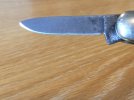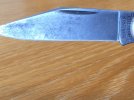- Joined
- Sep 28, 2014
- Messages
- 693
Howdy Y'all,
I have a Case 6318 in CV that is usually my EDC. The sheepsfoot blade on this particular knife did not have a very deep sharpening choil ground from the factory, and, over time, I have managed to sharpen the blade enough that the choil is now gone. There is still plenty of good, thin blade stock, so the blade is far from retirement. Here's my question:
I absolutely cannot abide seeing a blade, especially a sheepsfoot, that has a recurve sharpened into the heel. Call it OCD, or whatever you want, but I refuse to run my knives that way. I am being as vigilant as I can to sharpen all the way down to the ricasso, but I'm tempted to use a triangle needle file and make a new choil. I've never done that before, so I'd like some recommendations about whether or not it's a good idea. I'm also wondering if I will end up with ugly burrs on the faces of the blade, and how difficult those may be to clean up.
Any and all advice is welcome. Thanks!!!
I have a Case 6318 in CV that is usually my EDC. The sheepsfoot blade on this particular knife did not have a very deep sharpening choil ground from the factory, and, over time, I have managed to sharpen the blade enough that the choil is now gone. There is still plenty of good, thin blade stock, so the blade is far from retirement. Here's my question:
I absolutely cannot abide seeing a blade, especially a sheepsfoot, that has a recurve sharpened into the heel. Call it OCD, or whatever you want, but I refuse to run my knives that way. I am being as vigilant as I can to sharpen all the way down to the ricasso, but I'm tempted to use a triangle needle file and make a new choil. I've never done that before, so I'd like some recommendations about whether or not it's a good idea. I'm also wondering if I will end up with ugly burrs on the faces of the blade, and how difficult those may be to clean up.
Any and all advice is welcome. Thanks!!!




